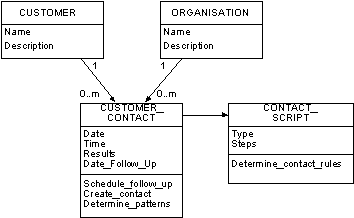|
(C) 1997 Lorrie Boyd, AMS Inc. Presented with kind permission.
Problem
Customer care is increasingly important in business. With customer
care customers need to feel stroked and looked after. How can
we change the focus of the business system from information 'about'
the customer to information about past, current and future 'interactions
with' the customer?
Context
In a day-to-day operational system, customers use the services
of the business. Customers contact the business with questions
and complaints, and the business contacts customers to evaluate
services or to encourage use of services.
To provide customer care, the business system must know the
history of customer contacts, detect trends in these contacts,
use these trends to drive responses to current questions, and
suggest proactive contacts in the future.
Forces
- Customers are contacted by many different organizations within
a business. The organizations may be competitive and protective
of their individual information.
- Customers want to be treated the same way no matter which
organization is contacting them.
- To track every customer contact in one class would create
many similar instances. If these large volumes are stored in
a single persistent data store, performance may be negatively
impacted.
- Management wants to know trends in customer queries. There
is a need to store and examine large amounts of data to discern
these trends.
Solution
Define a customer contact object. This object represents the
association between the business and the customer. Define attributes
such as the date and time of the contact, media used, and results.
Customer contacts can be both reactive and proactive. A reactive
contact happens when the customer contacts the business. A proactive
contact happens when the business contacts the customer. Proactive
contacts can be based on time (e.g., 2 months since last contact)
or on changes in contact trends.
In analysis, determine how different organizations contact
the customer. Do they use similar media? Are they capturing similar
information? Are they looking for similar trends? Is different
automation required for different contact media? Should the system
provide scripting for commonly asked questions?
The customer contact object can be useful for scheduling proactive
contacts, generating scripts and discerning trends. Examine the
volumes needed for trend analysis to determine if they are large
enough to warrant separation from the operational volumes.
Most importantly, the process of defining the contact object
can help change the focus of the system development effort from
customer information to customer care.
The customer contact association object looks like this:

Related patterns and known uses
The customer contact pattern is a variation of the association
object pattern, as an association between the business and the
customer. It is a business variation of Peter Coad's Event Logging
pattern (ref 1). The author has used it in help desk management,
telecommunications support, and work order customer services applications.
[ Previous | Up
| Next ]
|